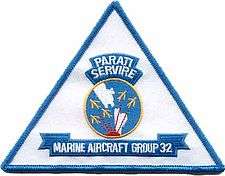Marine Aircraft Group 32
| Marine Aircraft Group 32 | |
|---|---|
|
MAG-32 insignia | |
| Active | 1 February 1943 – April 1947 |
| Country | United States |
| Allegiance | United States of America |
| Branch | United States Marine Corps |
| Role | Fighter/Attack Aircraft Group |
| Motto(s) | Parati Servire |
| Engagements |
World War II * Philippines campaign, 1944-45 |
| Commanders | |
| Notable commanders | John Lucian Smith |
Marine Aircraft Group 32 (MAG-32) was a United States Marine Corps aviation unit established during World War II.
History
World War II
Marine Aircraft Group 32 was commissioned on 1 February 1943 at Marine Corps Air Station Cherry Point, North Carolina. They trained there until January 1944 when they moved to the West Coast to prepare for follow on movement to the South Pacific. The group next went to Marine Corps Air Station Ewa, Hawaii where they remained until October 1944. November saw them move to Emirau as they prepared to support the campaign to recapture the Philippines.[1]
MAG-32 arrived on Mangaldan on 27 January 1945 where they became part of Marine Air Groups, Dagupan (MAGSDAGUPAN) along with Marine Aircraft Group 24 (MAG-24).[2] MAGSDAGUPAN fell under neath the 308th Bombardment Wing of the United States Army Air Forces which was supporting the 6th Army on Luzon. Portions of the group went ashore with the assault troops on Zamboanga on 10 March 1945. Two days later they were operating out of an expeditionary airfield.[1] During this time they became part of Marine Air Groups Zamboanga (MAGSZAM) along with Marine Aircraft Group 12 and Air Warning Squadron 4 (AWS-4). The SBD Dauntless aircraft of MAG-32 arrived on 23 March and began providing close air support. The first major operation that they supported was the landing of the 41st Infantry Division on Jolo Island on 9 April. Forty four dive bombers from MAG-32 were directed against Japanese positions by tactical air control parties.[3] The group also went on to cover amphibious landing on the islands of Parang-Cotabato, Sibago, Macajalar and Sarangani.[1]
MAGSZAM was finally dissolved on 30 August 1945.[1] During the recapture of the Philippines beginning in January 1945, MAG-32 and MAG-24 would fly a total of 8,842 combat sorties and drop more than 19,000 bombs as part of the Fifth Air Force in support of the Sixth Army.[4]
Following the end of World War II, MAG-32 participated in the occupation of Northern China.[1] The group returned to Marine Corps Air Station Miramar in June 1946 and was deactivated in April 1947 at Marine Corps Air Station El Toro.[5]
Korean War
Was active for about seven years into the Korean War. Key role was the bombardment of a North Korean held air base Inchon.
Vietnam War to the 1990s
The last two Marine Corps OA-4M Skyhawks, which were from MAG-32, flew their last flight from Marine Corps Air Station Cherry Point to NAS Patuxent River on 6 July 1990.
Unit awards
See also
- List of United States Marine Corps aircraft squadrons
- List of United States Marine Corps aircraft groups
Notes
- 1 2 3 4 5 Sherrod History of Marine Corps Aviation in WWII, pp. 445–446.
- ↑ Sherrod History of Marine Corps Aviation in WWII, p. 299.
- ↑ Sherrod History of Marine Corps Aviation in WWII, p. 317.
- ↑ "Selected January Dates of Marine Corps Historical Significance". History Division, United States Marine Corps. Retrieved 27 December 2007.
- ↑ RottmanU.S. Marine Corps WWII OOB, p. 436.
References
Books
- Rottman, Gordon L. (2002). U.S. Marine Corps World War II Order of Battle – Ground and Air Units in the Pacific War, 1939–1945.’’. Greenwood Press. ISBN 0-313-31906-5.
- Sherrod, Robert (1952). History of Marine Corps Aviation in World War II. Washington, D.C.: Combat Forces Press. ISBN 0-89201-048-7. OCLC 1261876.
- Shettle Jr., M. L. (2001). United States Marine Corps Air Stations of World War II. Bowersville, Georgia: Schaertel Publishing Co. ISBN 0-9643388-2-3.
Web
- Elliot, John M. (March–April 1995). "Back to the Philippines, Part II" (PDF). Naval Aviation News. Retrieved 9 June 2006.
- Fish, David L. "Capt. Doit L. Fish". American WWII Orphans Network. Retrieved 7 June 2006.
- "This Month in History". Selected July Dates of Marine Corps Historical Significance. History Division, United States Marine Corps. Retrieved 27 December 2007.

